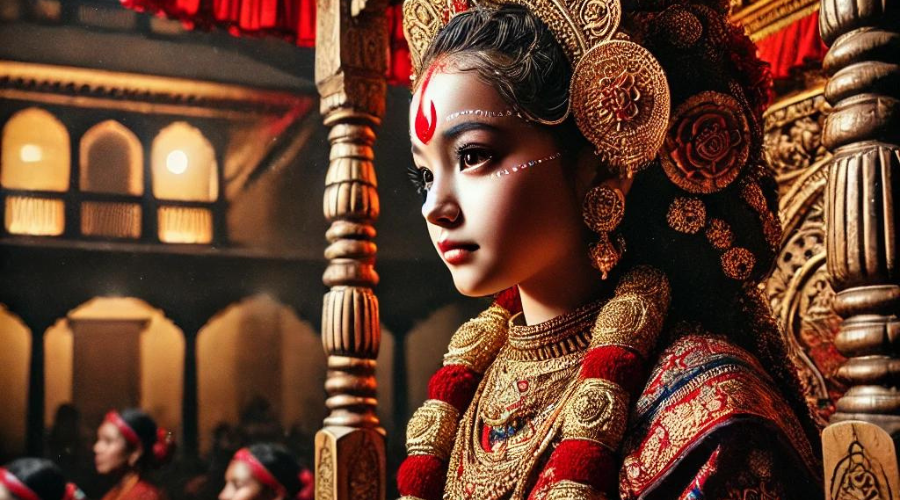
A Tale of Kumari, the Living Goddess: Taleju Bhawani's Legacy

A Tale of Kumari, the Living Goddess: Taleju Bhawani's Legacy
swotah travel
6593
14, 08 2024
Throughout the eons, centuries, and dynasties, Shaktism has been a persistent force in the succession of powerful kingdoms. In a way, fearsome goddesses were royal patronage or royal deities. History bears witness to the fact that the peak goddess-centric denomination of modern-day Hinduism, Shakitsm, is an integral part of Kathmandu Valley. Taleju Bhawani, one of the intense forms of Shakti and the ruler of Kathmandu valley, has always been given paramount importance, particularly during the Malla dynasty, as a tutelary deity or Isthadevi.
Even after the fall of the Malla dynasty, the worship and ritual of royal patronage continued during the Shah dynasty, despite the fact that the Shahs did not formally establish her as a tutelary goddess. Surprisingly, during the Rana regime, their profound reverence for Taleiju was openly displayed, given the tremendous power they held for 107 years.
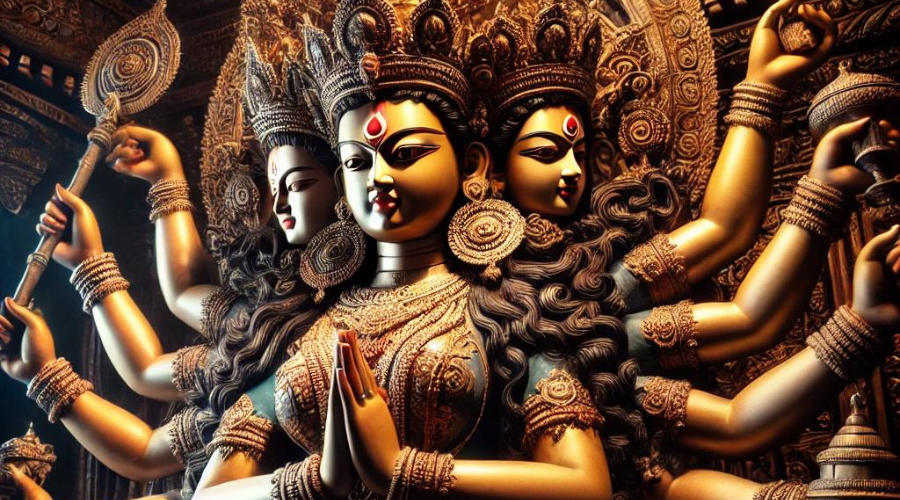
Photo: Digital Representation of the Sacred Goddess Taleju Bhawani
Exploring Shakti: The Divine Feminine Energy
Shakti means "energy"," power", or "force" in Sanskrit. In Hindu philosophy and theology, Shakti is perceived as pure consciousness and divine feminine energy, often personified as a goddess, Devi. But on a deeper level, Shakti transcends beyond the gender. Shaktas are the followers of Shaktis, who conceive the goddess as the ultimate truth and supreme deity, eternal reality. The supreme feminine element or consciousness is often referred to as the creative powers and primordial energy that fuels and governs the cosmos and universe.
The Puranas (ancient Hindu literature) provide three mediums for approaching any energy: Tantra, yantra, and mantra, and Shaktism is no indifferent. Shaktism can generally be classified into three types: tribal folk Shaktism, tantric / Yogic Shaktism, and Devotional or Bhakti Shaktism. The concept of Shakti is incredibly vast, esoteric, mystical, and secretive, making it difficult to explain to ordinary people.
Tantra in Shaktism: The Dual Paths to Enlightenment
The Tantra tradition argues for the attainment of both enlightenment and worldly enjoyment together, believing that there is no need to reject the materialistic world. Tantra supports both Orthodox and Heterodox beliefs, formulated along two paths: the left-hand path ( Vamachara) and the right-hand path ( Dakshinachara), both aimed at reaching the same goal.
Vamachara is chiefly associated with pancha-makara or the "5Ms", which are recognised as Pancha-tattva( five elements): Madya( wine), Mamsa(meat), Matsya(Fish), Mudra ( gesture) and Maithuna( sexual intercourse). This symbolic use of literal things, which are not typically endorsed in orthodox practices, can be considered Heterodox in that sense. Conversely, Dakhisnachara traditions fall under orthodox Hindu practice, insisting upon "purity".
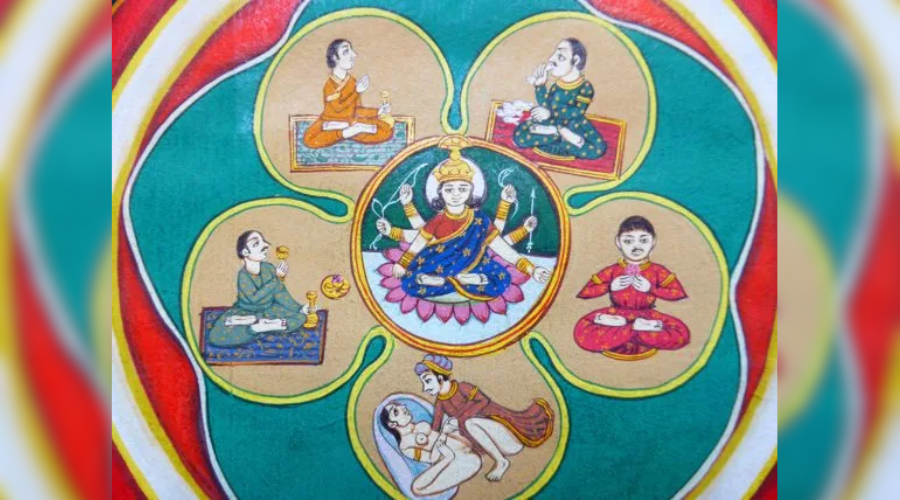
Photo: Depiction of the Sacred Pancha-Makara Elements
Nepal Mandala: The Spiritual Heart of Kathmandu
Nepal Mandala: Kathmandu is a reverberating point in every Nepali's life, an intriguing experience. A place as a power centre or a source of energy that has the ability to bring one closer to spirituality or enlightenment per se and charge the energies inside them, built in the shape of a Chakrasamvara Mandala -where the significant deity in Vajrayana ( tantra), Cakrasamvara resides in.
Cakrasamvara is made from the two words " Carka" and " " Samvara", which is simply translated to " wheel or circle" and "binding or vow," respectively, comes down to "Binding of the wheel" or "Union of the circle". Symbolically, unity of wisdom or path to enlightenment. Evidence that Nepal then had a planned and systematic urbanisation, unlike today's chaotic and unplanned urbanisation.
The Taleju Bhawani Temple: A Hidden Power Center
Exploring today's Kathmandu, a place that intricately interweaves between Archaicism and Modernization, a walking museum where every wooden window has a history to convey, the alley whispers the secret of the departed, and each brick preserves the essence of the ancient traditions. In divergence, the towering building, opposite the pagoda-style architecture, is writing its own story on the highrise skyline with its Google Pixelbook pen.
Trolling around the well-known Kathmandu Durbar( palace) square, also known as Hanuman Dhoka, in the centre of Kathmandu where a significant portion of archaeological and socio-cultural history is preserved. Hanuman Dhoka, named after the Monkey-faced god, a descendant of Lord Shiva and a prominent figure in Hindu Mythology in the scripture Ramayana, is situated at the entrance of the Durbar square.
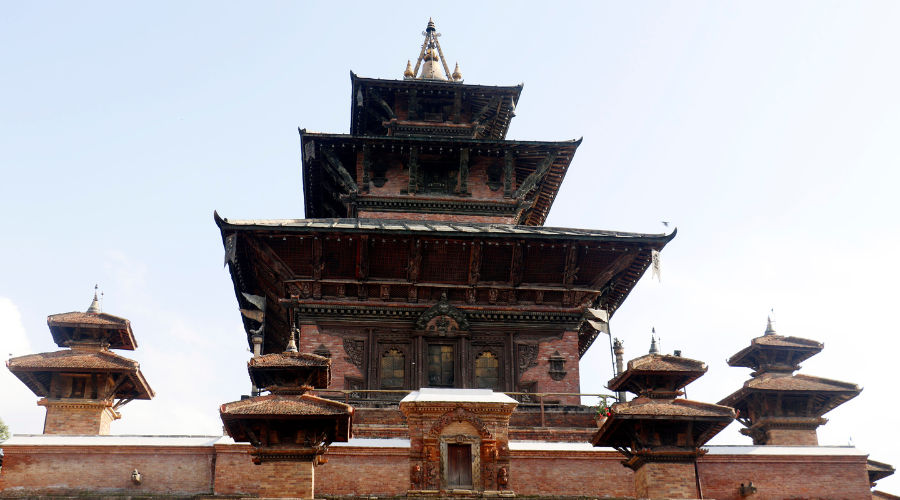
Photo: Taleju Bhawani temple, Kathmandu Durbar Square
The Mythological Background of Taleju Bhawani
A similar power centre, mostly obscured from ordinary people lies in the northeast direction of the Kathmandu Durbar square. Taleju Bhawani Temple traces back to the early 14th century, and 46 years were invested in its construction. It was officially built in 1564 by King Mahendra Malla in Kathmandu.
The temple is open to the public just one day a year, on the Ninth day (Nawami) of Dashain. Pertaining to the temple's architecture holds significant spiritual power as it is built in the shape of a Shri-yantra with protective deities encircling the temple. The elaborately carved wooden windows, gold painted door, and pinnacle The mystical goddess's rituals are often performed in complete secrecy, shrouded from the public. She is worshipped in her anionic form, in the shape of a yantra ( geometric diagram), but externally portrayed as a ten-armed Mahishasurmardidni to the general public. Several clouded stories are there concerning the origin of goddesses and the Kumari tradition.
In addition, the popular one is the story of Taleju, which starts at the beginning of time. In Hindu mythology, the epic battles between Goddess Durga and the demon Mahishashur and Shumbha-Nishumba originated nine-day festivals of Navratri in India and Dashain in Nepal, both of which celebrate Goddess Durga's victory over evil. It is believed that after the restoration of Indra's kingdom and peace, Shakti presented the most powerful Shri-Yantra, where she would reside.
According to Hinduism, time runs in a cyclic manner, and birth, death and rebirth are inescapable. In the Treta Yug, the epic story of Ramayan takes place, depicting the battle between good and evil -Ram and Ravan. In the ongoing battle, Ravan attacks Indra's kingdom, Amaravat, capturing the yantra and bringing it back to his kingdom-The secret behind the succession of Lanka.
The texts describe the city of Lanka, situated on the peak of Mount Trikuta, adorned with gold, akin to the city of Amaravati, the capital of Indra is depicted as appearing to be suspended in the sky,an ethereal city floating in the air.
After the end of the epic battle of the Ramayan, Ram retrieved the Sri Yantra and invoked it in the kingdom of Ayodhya. As his departure to Vaikuntha drew near, Goddess Durga instructed him to submerge the Sri Yantra in the river Sarayu,upon whose banks Ayodha was situated. Therefore, no future king would possess the potency and capability to perform the correct rituals as Ravana once did.
Over the millennium, King Nanyadev from Simraungadh, located in the Bara district of Nepal, had a dream in which Taleju Bhawani instructed him to find the Sri Yantra in the Sarayu River. The Sri Yantra was found and dutifully worshipped in the kingdom of Simraungadh, which thereafter experienced peace and prosperity bestowed by the goddess.
Around the 14th century, king Harishma Dev of Simraungadh was forewarned that Islamic conquests were spreading across the Indian Subcontinent and would soon reach the Gangetic plateau; Terai region of Nepal. He was warned of the impending bloodshed and the likelihood that the kingdom of Simraungadh would be in shambles, with a terrible loss in war. Consequently, he was urged to flee to the Emerald Valley, Bhaktapur, with Shri Yantra.
Following the guidance of the goddess, King Harishma Deva, along with the queen Devaldevi and his son Jagat Simha, fled northward. Unfortunately, on the way to the Dolkha, King Harishma passed away. The untimely death, however, did not lead to abandonment of the mission, as he whispered the secret mantra of devi into his son's ear.
Queen Devaldevi and Jagat Simah successfully reached Bhaktapur, Queen Devaldevi's paternal home. Certain criteria had to be met during the temple-building process, and Mul Chowk ultimately fulfilled all the conditions. The Shri Yantra was installed, and King Rudra Malla established the temple. Since then, the Malla dynasty has embraced Taleju Bhawani as a tutelary Goddess( ishta devi) of their clan.
The Division of the Malla Dynasty and the Flourishing of Culture
The division of the Malla dynasty into three states-Kathmandu, Bhaktapur, and Patan-led to the consecration of two more establishments that beautifully portrayed the intricate art and architecture of the Malla dynasty in the states of Kathmandu and Bhaktapur. All three temples were constructed at the same height so that the goddess would not have a hard time flying. During that time, it was even considered a heinous crime to build any structure higher than the temple of Taleju.
The division of Nepal Mandala, indeed, led to the flourishing of one of the most sophisticated and artistic civilisations in the Himalayan foothills. This period marked a pivotal point in shaping Nepal's history and fostering a culture of creativity, tolerance, and embracing diversity, which continues to define the nation's values to this day, laying a foundation for a pluralistic society.
The Origins of the Kumari Tradition
According to legends and oral storytelling, every night, Jay Prakash Malla would engage in a dice game(tripasa) with the Goddess Taleju, who appeared before him in all her ethereal beauty and offered guidance on state affairs. Captivated by her beauty, Jay Prakash Malla, in a moment of weakness, attempted to act on his desires. This act of impropriety towards the divine goddess invoked her wrath and she cursed the kingdom, foretelling its impending downfall. The goddess's abrupt disappearance left King Pratap Malla in great despair and remorse.
Sensing his genuineness and repentance, the ever-so-forgiving goddesses appeared to him in a dream. She decreed that she would no longer appear to him in her true form. Still, if he wished to continue worshipping her in a bodily form, she would inhabit the body of a pre-pubescent girl with 32 divine qualities from the Newar Shakya clan of a Buddhist family. Following this, the Malla ruled for another 12 years.
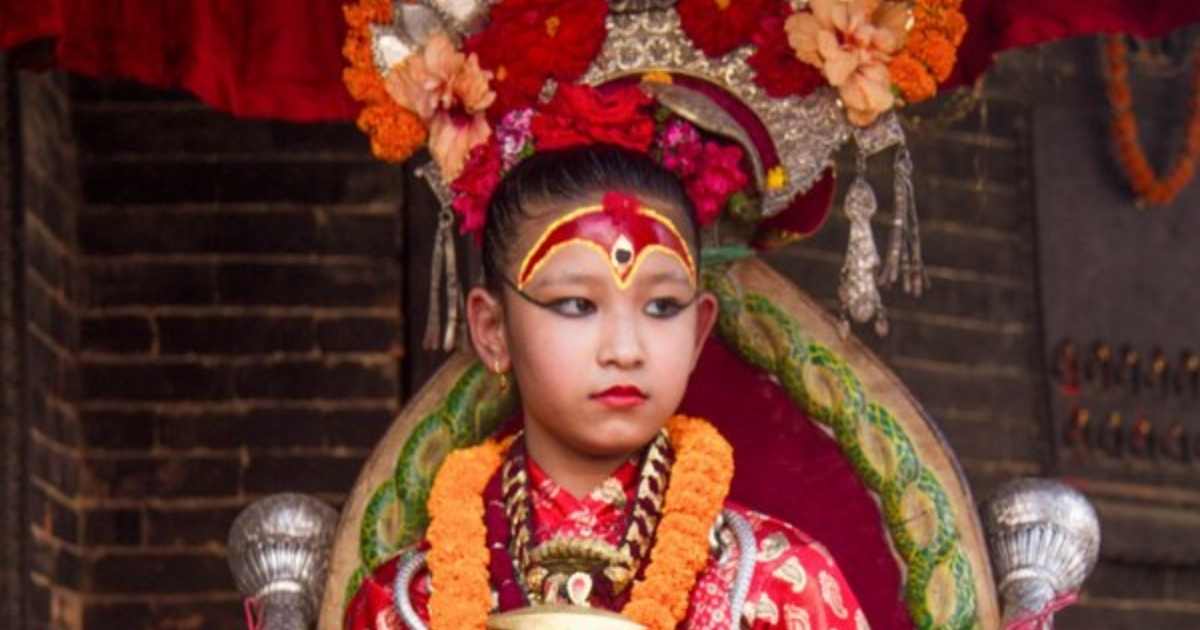
Photo: Kumari "Living Godness"
The Life and Rituals of the Living Goddess Kumari
Thus, after the end came a new beginning: the Kumari, the living goddess, was recognized as the incarnation of Taleju. The word kumari literally means "virgin" and is derived from the Sanskrit word "Kaumarya," meaning "princess". The selection process to find the chosen one is long and arduous. The potential candidate must endure a night in a room with 108 heads of buffaloes and goat heads, sacrificed to the goddess kali on the night of Kalratri during Dashain, accompanied by only a lit candle. Meanwhile, masked men attempt to frighten her with noises. If she remains fearless and unscathed throughout the night, then she is the chosen one. Moreover, she must possess certain physical attributes such as a body like the Banyan tree, legs like a deer, neck like a conch and eyebrows like the cow. She must never have lost a drop of blood. Buddhists, on the other hand, believed Kumari to be the goddess Vajradevi,who is often seen as the manifestation of Vajrayogini, a tantric deity representing the ultimate wisdom and feminine energy in Buddhism.
The are around ten kumaris in Nepal at present. Among them, the Royal Kumari is the most important, residing in Kumari Ghar, adjacent to the Gaddi Baithak, which was constructed by Jay Prakash malla. Throughout her time as the kumari, her feet must not touch the ground, and she is always carried in her golden palanquin by her caretakers. The kumari loses her divine power and returns to being an ordinary person if she experiences any blood loss, whether from a cut or a natural process like menstruation.
The Cultural Significance of Taleju Bhawani and the Kumari
Although the Kumari is born into a Buddhist family - revered as a Hindu goddess, she has predicted catastrophic incidents several times in Nepal's history, particularly concerning the country's kings and leaders. The deaths of king Tribhuvan, king Mahendra and the royal Masacare, were not directly foretold but rather indicated through subtle signs such as uncontrollable crying, rashes all over her body and similar occurrences. It is believed that loud laughter or crying causes serious illness or death; weeping or rubbing her eyes indicates imminent death; trembling foretells imprisonment; clapping of hands signifies a reason to fear for the king; and picking at food offerings predicts financial losses. A calm and expressionless Kumari signifies that everything is normal, which is the most desires state.
Even though Taleju is not originally a Newar deity, the Newar people, natives of Kathmandu, continue to hold her in utmost reverence to this date. While Newari priests from the Rajopadhaya and Karmacharya castes worship Taleju Bhawani, various other castes of the Newar group carry out nearly all tasks related to goddesses.
NEWSLETTER SIGNUP
Sign up to receive our trip ideas and travel offers!
Get updates and Exclusive Offers up to 20% Discount








